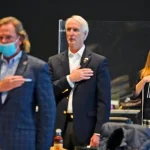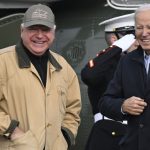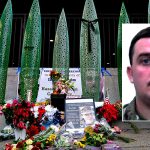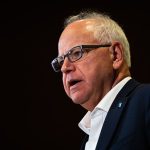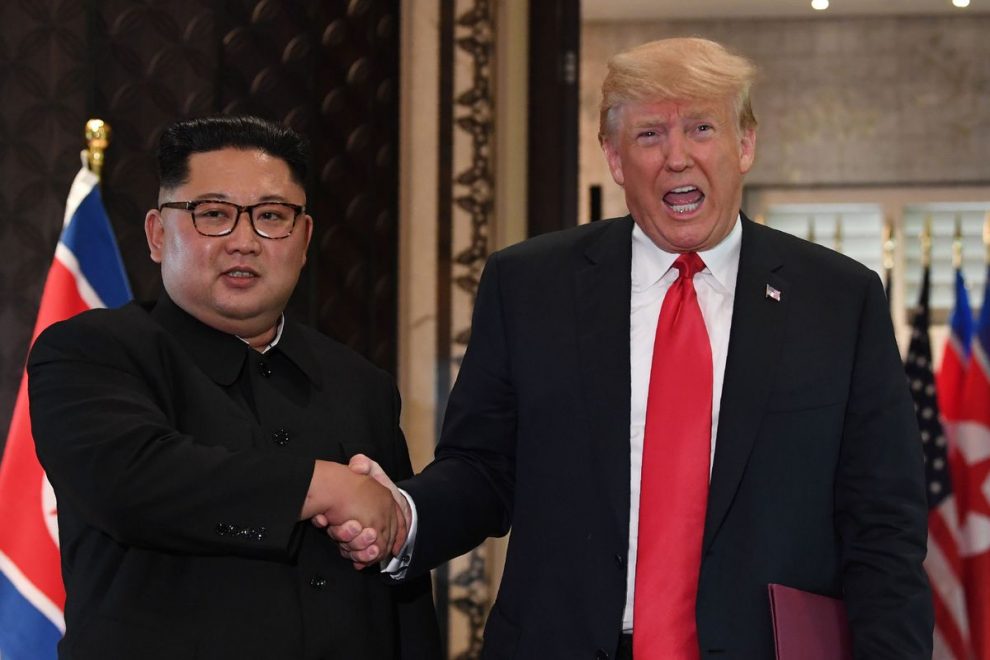SEOUL, South Korea — Taking an unprecedented step onto North Korean soil, President Donald Trump announced Sunday that Washington and Pyongyang will relaunch stalled nuclear talks during an extraordinary last-minute meeting with Kim Jong Un.
Side-by-side with Kim in the heavily-fortified demilitarized zone, Trump became the first sitting U.S. president to cross the 1953 armistice line separating North and South Korea, then joined Kim for a roughly 50-minute meeting.
It was their third since Trump took office, but none have yet yielded a nuclear deal.
“Stepping across that line was a great honor,” Trump said, later adding that it was “something incredible.”
Trump deemed the meeting a victory, announcing that nuclear talks would resume “within weeks” and that the two countries were designating teams of officials to take the lead.
He even invited Kim, who rarely leaves the country, to visit him at the White House.
Yet for all the fanfare, there were no signs that the U.S. and the North had made any concrete progress on denuclearization, the issue that has led to North Korea’s estrangement from the world.
And veteran nuclear negotiators and North Korea experts immediately questioned whether Trump, by staging a high-profile photo-op absent nuclear concessions, was bestowing legitimacy on Kim and undermining global pressure to force the North to accept a denuclearization deal.
“We can only call it historic if it leads to something,” said Victor Cha, a former Asia director at the White House and an NBC News contributor.
‘Things can happen’
The meeting capped an unpredictable three days of diplomacy in which Trump, while in nearby Japan for the G-20 summit of world leaders, issued an invitation to Kim on Twitter to meet him in the DMZ.
North Korea reacted positively, calling the proposal “interesting,” but did not confirm that Kim would accept until the last minute.
Even as Trump traveled by helicopter to the DMZ accompanied by a massive security contingent, U.S. officials had told NBC News they were unsure whether Kim would really show up.
And when he did, his handshake with Trump and their ensuing talks unfolded in chaotic fashion under overcast skies. Journalists jostled to capture the historic encounter and even White House officials accompanying the president seemed unsure what would happen next.
“This means that we can feel at ease,” Kim said of the meeting through a translator. “I believe that this will have a positive force on all of our discussions in the future.”
In a nod to the unforeseen nature of their rendezvous in the DMZ, Kim told Trump that he “never expected” to see the president “at this place.”
Trump and South Korean President Moon Jae-in landed mid-afternoon in the DMZ and rushed to a vista overlooking North Korea. Sean Morrow, commander of the U.N. Security Battalion, briefed Trump about the security situation, gesturing toward North Korean territory.
Minutes later, Trump and Kim were side by side posing for photos and taking a step together over the line into North Korea. They then spoke briefly to reporters inside a nearby room before holding talks that Trump had predicted would last just a few minutes but went on for close to an hour.
Both leaders predicted it would lead to better things to become between their two countries.
Of striking a nuclear deal, Trump said: “We’re not looking for speed, we’re looking to get it right.”
Leaving South Korea after a wonderful meeting with Chairman Kim Jong Un. Stood on the soil of North Korea, an important statement for all, and a great honor!
— Donald J. Trump (@realDonaldTrump) June 30, 2019
Trump was already the first U.S. president to meet a North Korean leader while in office, having met with Kim twice before. This marks the first meeting in the no-man’s-land between North and South since the end of the Korean War.
Trump’s last summit with Kim — in Hanoi, Vietnam, in February — collapsed abruptly, with a planned signing ceremony scrapped and Trump explaining to reporters that “sometimes you have to walk.”
At the center of that failure, U.S. officials have said, was Kim’s insistence that all nuclear sanctions be lifted in exchange for only some concessions sought by the U.S. from Pyongyang related to its nuclear program.
But a senior Trump administration official told NBC News ahead of the meeting Sunday that the administration was hoping that even a handshake might jump-start negotiations at a lower level led by Stephen Biegun, the U.S. special representative for North Korea.
Those talks could then focus on making more substantive progress on the nuclear issues.
Indeed, Trump said after the meeting that Biegun and Secretary of State Mike Pompeo would be handling the relaunched nuclear talks between the countries.
And while Trump said that sanctions on the North would remain in place for now, he seemed to leave open the possibility that some could be removed during the talks, a shift from the longstanding U.S. position that all sanctions remain in place until a denuclearization deal is struck.
“At some point during the negotiation, things can happen,” Trump said.
National security hawks and many of Trump’s critics have warned that such meetings plays into Kim’s hands, boosting him domestically and providing room for Pyongyang to continue to stall while it moves ahead with its nuclear program.
North Korea is believed to have dozens of nuclear warheads and the ability to mount them on missiles, but has yet to prove it can deliver those nuclear-tipped missiles successfully to distances as remote as the U.S. mainland.
‘He understands me’
Yet Trump projected no sense of urgency on Sunday as he argued there was plenty of time to reach a deal with North Korea, echoing an argument he’d made about resolving the Iran nuclear issue the day before.
“I’m never in a rush,” Trump said. “If you’re in a rush, you get yourself in trouble.”
Both Trump and Kim offered invitations to the other to visit their capitals, with Trump saying, “I’ll invite him to the White House right now.” Kim said it would be a “great honor” if Trump visited Pyongyang.
Neither of those are likely to occur in the short term given the immense logistical and security challenges of arranging such a visit between countries that do not have diplomatic relations.
Yet as he talked up his own diplomatic achievements, Trump took significant liberties with history.
He said inaccurately that former President Barack Obama had wanted to meet with Kim but been rejected. He also claimed that tensions with the North had dissipated as soon as he took office, when in fact Trump engaged in a war of words with the North — including his threat to unleash “fire and fury” — that caused significant alarm across Asia and beyond.
“We’ve had peace for two and a half years,” Trump said Sunday.
The president also glossed over reports that Kim had ordered some of his negotiators executed following the failed Hanoi summit. Asked whether they were still alive, Trump said “I think they are,” adding that the main person the U.S. was familiar with was still living.
“I would hope the rest are too,” Trump said. “I would really hope the rest are too. “
Earlier, standing with Moon at the Blue House, South Korea’s equivalent of the White House, Trump said that he and Kim “understand each other, I do believe.”
He said that both he and Kim wanted to hold the meeting “from the beginning.”
“He understands me, and I believe I maybe understand him,” Trump said. “Sometimes that can lead to very good things.”
National security hawks and many of Trump’s critics have warned that such meetings plays into Kim’s hands, boosting him domestically and providing room for Pyongyang to continue to stall while it moves ahead with its nuclear program.
North Korea is believed to have dozens of nuclear warheads and the ability to mount them on missiles, but has yet to prove it can deliver those nuclear-tipped missiles successfully to distances as remote as the U.S. mainland.
‘He understands me’
Yet Trump projected no sense of urgency on Sunday as he argued there was plenty of time to reach a deal with North Korea, echoing an argument he’d made about resolving the Iran nuclear issue the day before.
“I’m never in a rush,” Trump said. “If you’re in a rush, you get yourself in trouble.”
Both Trump and Kim offered invitations to the other to visit their capitals, with Trump saying, “I’ll invite him to the White House right now.” Kim said it would be a “great honor” if Trump visited Pyongyang.
Neither of those are likely to occur in the short term given the immense logistical and security challenges of arranging such a visit between countries that do not have diplomatic relations.
Yet as he talked up his own diplomatic achievements, Trump took significant liberties with history.
He said inaccurately that former President Barack Obama had wanted to meet with Kim but been rejected. He also claimed that tensions with the North had dissipated as soon as he took office, when in fact Trump engaged in a war of words with the North — including his threat to unleash “fire and fury” — that caused significant alarm across Asia and beyond.
“We’ve had peace for two and a half years,” Trump said Sunday.
The president also glossed over reports that Kim had ordered some of his negotiators executed following the failed Hanoi summit. Asked whether they were still alive, Trump said “I think they are,” adding that the main person the U.S. was familiar with was still living.
“I would hope the rest are too,” Trump said. “I would really hope the rest are too. “
Earlier, standing with Moon at the Blue House, South Korea’s equivalent of the White House, Trump said that he and Kim “understand each other, I do believe.”
He said that both he and Kim wanted to hold the meeting “from the beginning.”
“He understands me, and I believe I maybe understand him,” Trump said. “Sometimes that can lead to very good things.”
Story cited here.


